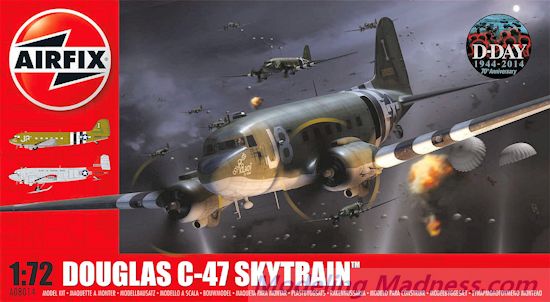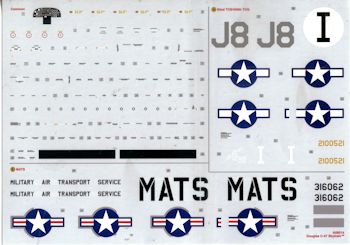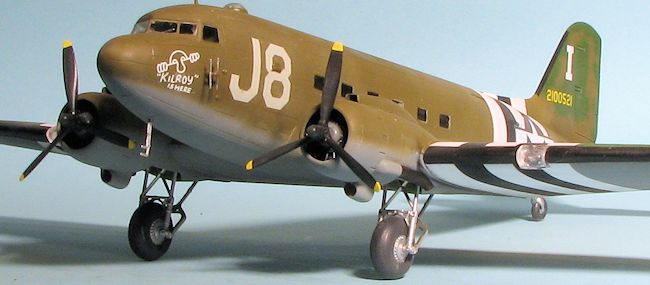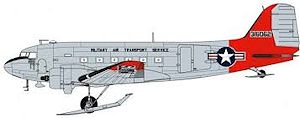
Airfix 1/72 C-47 Skytrain
| KIT #: | A 08014 |
| PRICE: | $39.99 SRP |
| DECALS: | Two options |
| REVIEWER: | Scott Van Aken |
| NOTES: | New tool kit |

| HISTORY |
The C-47 was vital to the success of many Allied campaigns, in particular those at Guadalcanal and in the jungles of New Guinea and Burma where the C-47 (and its naval version, the R4D) made it possible for Allied troops to counter the mobility of the light-traveling Japanese army. Additionally, C-47s were used to airlift supplies to the embattled American forces during the Battle of Bastogne. Possibly its most influential role in military aviation, however, was flying "The Hump" from India into China. The expertise gained flying "The Hump" was later be used in the Berlin Airlift, in which the C-47 played a major role, until the aircraft were replaced by Douglas C-54 Skymasters.
In Europe, the C-47 and a specialized paratroop variant, the C-53 Skytrooper, were used in vast numbers in the later stages of the war, particularly to tow gliders and drop paratroops. In the Pacific, with careful use of the island landing strips of the Pacific Ocean, C-47s were even used for ferrying soldiers serving in the Pacific theater back to the United States.
C-47s (approx. 2,000 received under lend-lease) in British and Commonwealth service took the name Dakota, from the acronym "DACoTA" for Douglas Aircraft Company Transport Aircraft. The C-47 also earned the informal nickname Gooney Bird in the European theater of operations.
Other sources (C-47/R4D Skytrain Units of the Pacific and CBI, David Isby, Osprey Combat Aircraft #66, Osprey Publishing Limited, 2007) attribute this name to the first plane, a USMC R2D - the military version of the DC-2 - being the first plane to land on Midway Island, previously home to the native long-winged albatross known as the Gooney Bird which was native to Midway.
The United States Air Force's Strategic Air Command had Skytrains in service from 1946 through 1967.
With all of the aircraft and pilots having been part of the Indian Air Force prior to Independence, both the Indian Air Force and Pakistan Air Force used C-47s to transport supplies to their soldiers fighting in the Indo-Pakistan War of 1947.
Several C-47 variations were used in the Vietnam War by the United States Air Force, including three advanced electronic warfare variations, which sometimes were called "Electric Gooneys" designated EC-47N, EC-47P, or EC-47Qs depending on the engine used. EC-47s were also operated by the Vietnamese, Laotian and Cambodian Air Forces. A gunship variation, using three 7.62mm miniguns, designated AC-47 "Spooky" often nicknamed "Puff the Magic Dragon" also was deployed.
The Royal Canadian Air Force and later, the Canadian Armed Forces employed the C-47 for transportation, navigation, and radar training, as well as for search and rescue operations from the 1940s to the 1980s.
After World War II thousands of surplus C-47s were converted to civil airline use, some remaining in operation in 2014 as well as being used as private aircraft.
| THE KIT |
 an be
attached for the second option. If not using skis, these need to be removed.
Each of the skis are five part constructs with the little wing on the back. Both
the cockpit door and cabin cargo doors are separate with the cargo door having a
separate passenger door. The cargo doors can be posed optn. All of the clear
bits are separate and fit from the outside. This includes a three piece cockpit
windscreen and side pieces.
an be
attached for the second option. If not using skis, these need to be removed.
Each of the skis are five part constructs with the little wing on the back. Both
the cockpit door and cabin cargo doors are separate with the cargo door having a
separate passenger door. The cargo doors can be posed optn. All of the clear
bits are separate and fit from the outside. This includes a three piece cockpit
windscreen and side pieces.
Though there are no separate ailerons or flaps, the rudder and elevators are separate bits. The kit includes both the earlier pointy tip props in addition to the later paddle blade versions. I would bet that other boxings will be coming on this one.
 Instructions
are well drawn in a 3D form and include some color bits. The booklet is on a
newspaper quality paper with the all Humbrol paint numbers. Two markings options
are provided. First is the box art plane "Kilroy is Here" which is the warbird
on which the kit was based. This is a markings option I used on one of my
Italeri C-47s last year and is a nice one though painting intensive due to the
invasion stripes. It has also been featured in aftermarket sheets and other kits
so it would have been nice to have something different for the WWII option. The
other option is a
Instructions
are well drawn in a 3D form and include some color bits. The booklet is on a
newspaper quality paper with the all Humbrol paint numbers. Two markings options
are provided. First is the box art plane "Kilroy is Here" which is the warbird
on which the kit was based. This is a markings option I used on one of my
Italeri C-47s last year and is a nice one though painting intensive due to the
invasion stripes. It has also been featured in aftermarket sheets and other kits
so it would have been nice to have something different for the WWII option. The
other option is a
 post-war
version in overall aluminum with red Arctic markings, operating out of Isachsen
Airstrip in northern Canada in 1949. This is the options with the skis.
The decal sheet is nicely done and has all sorts of data markings. It also has
wing walk areas for the post-war option as well as an instrument panel decal.
The wing and fuselage insignia for the post-war plane have silver backgrounds
where it goes over the red. There is also a silver rectangle for the tail
serial. You will need to mask the cut outs for the MATS logo.
post-war
version in overall aluminum with red Arctic markings, operating out of Isachsen
Airstrip in northern Canada in 1949. This is the options with the skis.
The decal sheet is nicely done and has all sorts of data markings. It also has
wing walk areas for the post-war option as well as an instrument panel decal.
The wing and fuselage insignia for the post-war plane have silver backgrounds
where it goes over the red. There is also a silver rectangle for the tail
serial. You will need to mask the cut outs for the MATS logo.
| CONCLUSIONS |
| REFERENCES |
http://en.wikipedia.org/wiki/C-47_Skytrain
September 2013
Thanks to me for the preview kit.
If you would like your product reviewed fairly and fairly quickly, please contact the editor or see other details in the Note to Contributors.
Back to the Previews Index Page